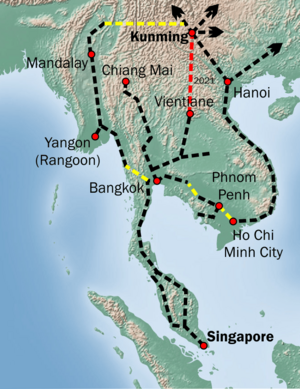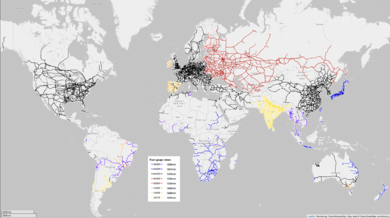Trans–Asian railway facts for kids
The Trans-Asian Railway (TAR) is a big plan to connect countries across Europe and Asia with a huge railway network. It's like building a super-highway for trains! This project is managed by the United Nations Economic and Social Commission for Asia and the Pacific (UNESCAP).
The idea for the Trans-Asian Railway started way back in the 1950s. The goal was to create a continuous train track stretching about 14,000 kilometers (8,750 miles). This track would go all the way from Singapore to Istanbul, Turkey. There were even plans to connect it further to Europe and Africa. Back then, shipping goods by sea or air wasn't as easy or fast. So, this train project promised to make sending things between Europe and Asia much quicker and cheaper. However, political and money problems slowed down the project for many years. By the 1990s, things got better, and countries started working together more. This made the dream of a rail network across Asia seem possible again.
The TAR was seen as a great way to handle the huge increase in trade between countries in Europe and Asia. It would make it easier to move goods around. It was also a big help for countries that don't have a coastline, like Laos, Afghanistan, Mongolia, and the countries in Central Asia. These countries could use the railway to connect to the rest of the world.
A lot of the railway tracks for the TAR already exist. They are part of what's called the Eurasian Land Bridge. But there are still some big gaps. One of the biggest challenges is that different countries use different rail gauges. A rail gauge is simply the distance between the two rails on a train track.
There are four main rail gauges used across Asia:
- Most of Europe, Turkey, Iran, China, and the Koreas use the 1,435 mm (4 ft 8 1⁄2 in) gauge. This is called the Standard gauge.
- Russia and many former Soviet countries use a 1,520 mm (4 ft 11 27⁄32 in) gauge. Finland uses a very similar 1,524 mm (5 ft) gauge. Both are known as Russian gauge.
- India, Pakistan, Bangladesh, and Sri Lanka use the 1,676 mm (5 ft 6 in) gauge, called Indian gauge.
- Most of Southeast Asia uses a 1,000 mm (3 ft 3 3⁄8 in) gauge, known as metre gauge.
The TAR project doesn't plan to change all these different track widths. Instead, special places called "break-of-gauge" points will be built. At these points, machines will move shipping containers from a train on one type of track to a train on another type of track. This way, goods can keep moving without having to unload and reload everything.
Contents
Main Routes of the Trans-Asian Railway
By 2001, experts had looked at four main routes for the Trans-Asian Railway. These routes are designed to connect different parts of the continent.
Northern Corridor
This route connects Europe and Northeast Asia. It goes through countries like Germany, Poland, Belarus, Russia, Kazakhstan, Mongolia, China, North Korea, and South Korea. Along this route, trains will need to switch tracks at the borders of Poland-Belarus, Kazakhstan-China, and Mongolia-China because of different rail gauges.
A big part of this route is the 5,750 miles (9,250 km) Trans-Siberian Railway. This railway already carries a lot of goods from East Asia to Moscow and then into the rest of Europe. Because of political issues with North Korea, goods from South Korea currently have to be shipped by sea to a port in Russia to join this route.
Southern Corridor
This route is also known as ITI-DKD-Y, which stands for Istanbul-Tehran-Islamabad-Delhi-Kolkata-Dhaka-Yangon. It connects Europe to Southeast Asia. It passes through Turkey, Iran, Pakistan, India, Bangladesh, Myanmar, and Thailand. There are also links planned to China's Yunnan Province and, through another route, to Malaysia and Singapore.
There are still some gaps in the tracks that need to be built, especially in India, Bangladesh, and Myanmar. Also, trains will need to switch tracks at the Iran-Pakistan border, the India-Myanmar border, and when connecting to China due to different rail gauges.
Southeast Asian Network
This part of the project mainly focuses on the Kunming–Singapore Railway. This railway aims to connect Kunming in China all the way down to Singapore, passing through several Southeast Asian countries.
North-South Corridor
This route connects Northern Europe to the Persian Gulf. It starts in Helsinki, Finland, and goes through Russia to the Caspian Sea. From there, it splits into three paths:
- A western path through Azerbaijan, Armenia, and western Iran.
- A central path that crosses the Caspian Sea using a rail ferry to Iran.
- An eastern path through Kazakhstan, Uzbekistan, and Turkmenistan to eastern Iran.
All these paths meet up in Iran's capital city, Tehran, and continue to the Iranian port of Bandar Abbas.
Trans-Asian Railway Network Agreement
The Trans-Asian Railway Network Agreement is an important document signed on November 10, 2006. Seventeen Asian countries signed it as part of the UNESCAP's plan to build this huge railway network. This plan is sometimes called the "Iron Silk Road". This name reminds us of the old Silk Road trade routes that connected East and West many centuries ago. UNESCAP started working on this idea in 1992.
The agreement officially began on June 11, 2009.
The Railway Network
The Trans-Asian Railway system will have four main railway routes. Part of the existing Trans-Siberian railway in Russia, which connects Moscow to Vladivostok, will be used. Another route will connect China to Korea, Mongolia, Russia, and Kazakhstan.
Different Standards for Railways
A big challenge for the plan is the different rail gauges (track widths) used across the continent.
- China, Iran, Laos, and Turkey use 1,435 mm (4 ft 8 1⁄2 in) standard gauge tracks.
- Russia and Central Asian countries use 1,520 mm (4 ft 11 27⁄32 in) tracks.
- In South Asia, India and Pakistan use 1,676 mm (5 ft 6 in) tracks.
- In Southeast Asia, countries like Myanmar, Thailand, Vietnam, and Malaysia mostly use 1,000 mm (3 ft 3 3⁄8 in) metre gauge tracks. Indonesia and Japan mostly use 1,067 mm (3 ft 6 in) gauge.
These differences mean that trains often have to stop at borders. Goods then need to be moved from one train to another, or the train's wheels might even need to be changed. This takes a lot of time.
Besides track width, other things need to be considered for trains to work together smoothly:
- Railway electrification: How trains get their power, usually from overhead lines.
- Couplings: The way train cars are linked together.
- Brakes: The systems used to stop trains.
- Loading gauge: The maximum size of a train or its cargo so it can fit under bridges and through tunnels.
- Signalling systems: How trains communicate and know when to stop or go.
- Rules and regulations: Different countries have different rules for trains.
- Language: How people from different countries communicate about the railway.
- Break of gauge devices: Special ways to deal with different track widths, like special axles that can change width.
Countries Involved
Transportation and railway ministers from 41 nations met in Busan, South Korea, to create this agreement. The proposed railway network is planned to be about 80,900 kilometers (50,270 miles) long. It will start from the Pacific coast of Asia and reach the borders of Europe.
The following countries signed the agreement:
Countries that didn't sign right away had until December 31, 2007, to join. Bangladesh and India later announced they would sign the agreement. India plans to spend a lot of money to build and fix rail links with its neighbor, Myanmar. Bangladesh signed the agreement on November 10, 2007.
Progress So Far
The Northern Corridor has been working since the 1960s, at first mainly for trade between the Soviet Union and China. The Southern Corridor has been opening up more since 2000. Here are some of the successes:
Northern Line Progress
- A rail link from China to Kazakhstan was finished in 1990. This allows cargo services like the Yiwu–London and Chongqing–Xinjiang–Europe lines to operate.
- A second link from China to Kazakhstan was completed in December 2011.
- Direct freight services between Germany and China through Russia and Mongolia or Kazakhstan have been running since the early 2000s.
Southern Line Progress
- The Marmaray Tunnel in Turkey, which connects European and Asian Turkey, opened in 2013. It was fully connected to the rail network in 2019. The first international freight train carrying goods from Turkey to Austria went through this tunnel in October 2019. Before this, trains used a ferry across the water.
- A train ferry across Lake Van in Turkey has allowed train services between Turkey and Iran since the 1970s.
- A link from Iran to Central Asia was finished in 1996.
- A link from Iran to Herat in Afghanistan was completed in 2013.
- The rail link between Bam in Iran and Zahedan in Pakistan was completed. There is a break-of-gauge at Zahedan because Pakistan uses a wider track. In August 2009, a goods train traveled from Islamabad, Pakistan to Istanbul, Turkey. By April 2011, trains were running regularly.
- In 2016, Bangladesh decided to connect to the network with a new rail line near the Myanmar border.
Southeast Asia Progress
- The Boten–Vientiane railway opened in December 2021. This completed a key part of the line, creating a nearly continuous train connection from Kunming (China) to Singapore. There is still a break-of-gauge in Vientiane, where goods need to be transferred.
North–South Transport Corridor Progress
- In 2014, Iran, Azerbaijan, and Russia agreed to complete the north–south corridor. A missing part of the track, about 167 kilometers (104 miles) long, is planned to start construction in 2017.
See also
 In Spanish: Ferrocarril Transasiático para niños
In Spanish: Ferrocarril Transasiático para niños
- TransAfricaRail
- African Union of Railways
- Asian Highway Network
- Bandhan Express
- Cosmopolitan Railway
- Greater East Asia Railroad
- Intercontinental and transoceanic fixed links
- International Union of Railways
- Japan–Korea Undersea Tunnel
- Gyeongui Line
- Košice–Vienna broad-gauge line
- Maitree Express
- Northern East West Freight Corridor
- One Belt, One Road
- Transcontinental railroad
- Transmountain railroad
- International North-South Transport Corridor



